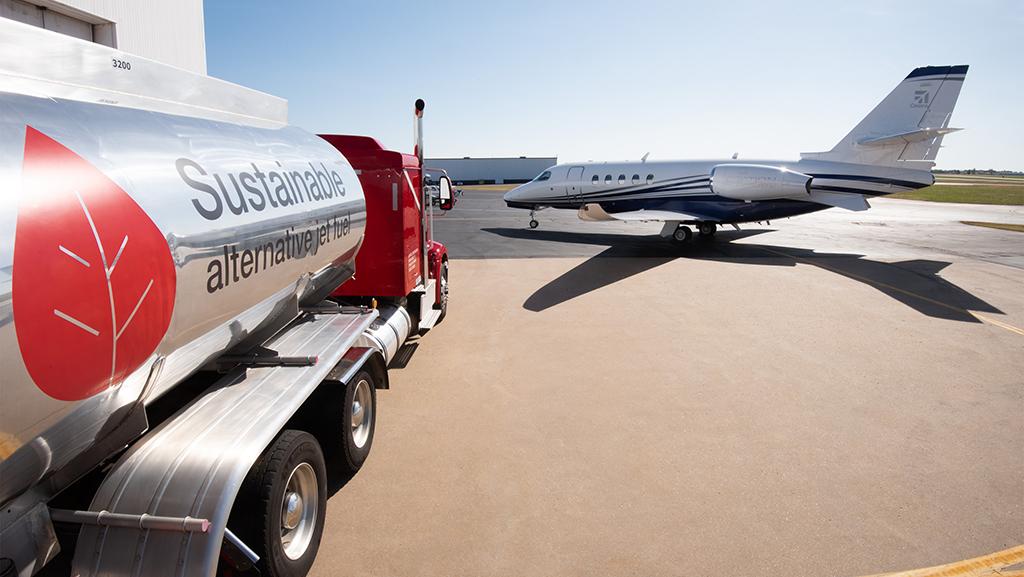
Every aspect of the aviation ecosystem has been hit hard by the COVID-19 pandemic and the ensuing downturn in travel demand, but in a small number of instances the effects have been beneficial. One area to have seen an enhanced and increased focus is sustainability.
Even as the reduction in flying hours has brought challenges to aviation businesses, the resultant drop in greenhouse gas emissions has helped strengthen arguments for sustainability initiatives, both among the public and within the industry.
“Business aviation has long been at the forefront of innovation,” NBAA President and CEO Ed Bolen told the association’s Virtual 2020 Business Aviation Sustainability Summit last month. “We were leaders in composite technologies; we were early adopters of GPS; we were the first sector of aviation to adopt winglets, and we’ve seen constant improvements in the efficiencies of our propulsion systems.”
Today, Bolen says, business aviation is taking the lead on the adoption of sustainable aviation fuels (SAF). Although criticized by climate campaigners as not contributing sufficient reductions to bring aviation close to net-zero emissions, proponents argue SAF’s benefits to the environment will help reduce emissions during the decades it is likely to take before viable alternative propulsion systems are developed to permit zero-emissions flying.
Nevertheless, SAF remains a tough sell. It is more expensive than conventional fossil fuels, and prices only will drop when demand drives production volumes higher. Airplane manufacturers, fuel providers, airports, operators and passengers all have to make reasonably tough decisions—often resulting in medium-term increases in expenditures—if the benefits of SAF are to be realized.
THE OEMs
While aircraft and engine manufacturers continue efforts toward achieving zero-carbon-propulsion systems, the industry sees SAF as providing the best means of reducing emissions across the current fleet. SAF has to comply with ASTM International’s D7566 standard; the D1655 standard, which defines Jet A/A1 fuel, allows for synthetic fuels compliant with D7566 to be recertified as compliant with D1655, either “neat” or in blends with standard Jet A. As a result, SAF can be used in all aircraft and engines where Jet A/A1 is consumed.
FUEL PRODUCERS
A paradox at the heart of the SAF ecosystem is these drop-in fuels are nevertheless different, and thus have not as yet been approved for use in undiluted form. Of the seven “pathways” so far approved for SAF production—each involving a different combination of feedstock (the renewable source material) or refining process—five are approved for blending at up to a 50:50 ratio with Jet A, while two are limited to a 10:90 blend.
It is possible pure SAF eventually will be approved for use but for now, specialist providers of renewable fuel are in partnerships with established fuel suppliers and feed their product into the wider aviation fuel supply chain. For example, Finnish company Neste is the largest supplier of SAF and is partnered with AirBP and Shell Aviation; Avfuel sources its SAF from Gevo Inc., and World Fuel Services works with Boston-headquartered alternative-fuels provider World Energy.
THE DISTRIBUTION CHAIN
If a SAF production facility is a considerable distance from an airport where a customer wishes to buy the fuel, the carbon emissions involved in getting it there may negate the benefits of putting SAF in the aircraft. And there are relatively few sites where SAF is easily available. According to the Air Transport Action Group, the Geneva-based industry association, only six airports in the world receive a regular supply.
To try to get around this problem, the industry has developed a concept it calls “book and claim.” This works in a manner similar to carbon-offsetting, in that it allows the benefits of reduced-emissions flying to accrue to those customers willing to pay for SAF, even if they are unable to use it on their own flights. Under book and claim, operators willing to pay for SAF will receive the certified carbon-reduction benefits of their purchases, even if the aircraft is fueled at a location where SAF is not available. Somewhere else, a flight for which SAF has not been booked will receive that fuel, to help lower emissions across the sector.
THE END USER
Corteva Agriscience is a relatively new company, one of three spun off in 2019 following the merger of Dow Chemical and DuPont. Its aviation director, Craig Hanlon, told the NBAA’s summit how the business had been on a steep SAF learning curve but, with help from across the industry, was quick to realize the important role sustainable fuels could play.
“The agriculture industry has taken its fair share of bad press over emissions,” Hanlon said, “but our CEO, Jim Collins, said that he did not want to be part of the problem, he wanted to be part of the solution.”
Corteva was introduced to SAF when exploring ways to offset emissions for executives on flights to the World Food Prize in Des Moines, Iowa, last year. A week later, Hanlon noted, numerous business aircraft flew to and from the annual NBAA convention in Las Vegas on SAF. The company was about to buy a new Gulfstream G550, and discussions with the manufacturer and fuel provider Avfuel led to SAF being made available for the aircraft’s delivery flight and at the company’s FBO, Atlantic Aviation, in New Castle, Delaware (KILG). Corteva received its first “demonstration delivery” last month—7,300 gal. of SAF from Avfuel (a G550 has a fuel capacity of 6,190 gal.). The SAF delivery will bring Corteva a 2-metric-ton reduction in net CO2 emissions.
Hanlon’s advice to others who wish to follow this path is simple. “If you’re new to sustainability and you want to put together a program, I recommend reaching out to your OEM, to your fuel provider and to your sustainability group within your company,” he said. “These are very valuable resources that can help you put your plan together.”





